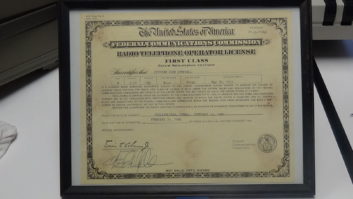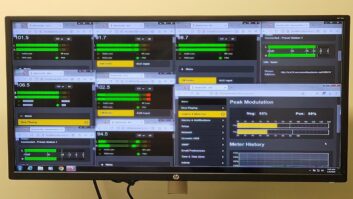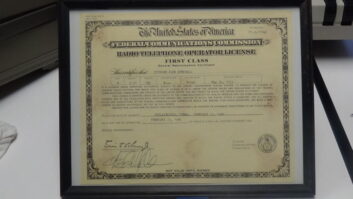BRUGES, Belgium — Vrije Brugse Radio Omroep (“Free Bruges Radio”) is counting on its unique content offering and upgraded technology to earn it an FM frequency license for the Flemish region of Belgium.

Director Frederik Thomas at work in Production Booth 2.
all pics © VBRO radio
The station launched on the FM band as a local station in Bruges in 1981 and today, VBRO operates nine frequencies in West-Flanders and another three in East-Flanders, covering the majority of the western part of the country.
Originally the station aired 1980s hits with additional specific night time music genre programs, such as classical music, jazz, country. In 1988 VBRO began offering an AC format, playing the hits of the sixties through the nineties.
UNIQUE FORMAT
“With bigger commercial stations like 4FM (now Joe) and Nostalgie eyeing their share of the market, we had to make choices,” said Frederik Thomas, director of VBRO.
So in 2009, Thomas made the radical decision to focus on what had, over the years, become one of VBRO’s key strengths — Dutch-language music.
“From then on, we concentrated on the Dutch-language repertoire, from both sides of the [Belgium/Netherlands] border, with artists ranging from Flemish Will Tura to Dutch Rob De Nijs,” he said. “It was a risk, but in order to survive as a radio station, we implemented this style change — and it paid off.”

Presenter Rudy Meyns with Dutch singer Jan Smit in the radio station’s artist gallery.
VBRO gradually transitioned more Dutch-language content into its playlists until the current format was put in place. “I do admit that, even today, we still have one or two English-language tracks on the list, not every hour though — and from artists who fit the station’s profile,” Thomas said. “Today, VBRO has a unique format in Flanders, and pulls in 7 percent of the audience share in West-Flanders.”
With a tagline dubbed “VBRO — Ik luister Nederlandstalig” (“VBRO — I listen to Dutch-language music”), the station, owned and managed by Frederik and Olivia Thomas, employs five full-time employees and some 20 independent freelancers.
In 2015, VBRO launched sister station VBRO Evergreen, which airs commercial music from the 1960s to 1990s. In the same move, the station also upgraded its network connectivity — most of VBRO’s 12 transmitter sites are now linked with the main studio in Bruges via IP RTP [real-time transport protocol] connections.
IMPROVED CONNECTIVITY
Three sites remain connected to the broadcast-center in Bruges through a microwave link. Thomas said the specificity of the locations and the reliability of the link was an incentive for the broadcaster to continue using this type of connectivity.

Mathieu De Blauwe, VBRO’s morning drive host, broadcasts “VBRO Ontbijtshow” (“VBRO Breakfast Show”) live.
VBRO has an on-air studio and five technical rooms for recording, editing and production. Today, VBRO’s programs are presented live from the on-air studio, while VBRO Evergreen’s programs are aired with live and prerecorded presentation.
“This summer, we are putting in place an Axia Livewire core 32-engine configuration,” said Hannes Roygens, VBRO engineer. “This will allow us to go live on air with all our VBRO stations simultaneously. We will also replace the current Dateq BCS50 console with a new double Axia IQ eight-fader main console with a QOR.32 integrated console engine.
The big advantage of the Livewire set-up lies in the functionalities, allowing us to link up our studios and mixing audio content like for instance our regional advertising and (in future) news bulletins.”
The Livewire installation, which is expected to be complete by the end of August, will feature GPIO (general purpose in/out) for data transfer to the respective transmitters sites, which are equipped with DB Broadcast and Elettronika transmitters along with Aldena antennas.
VBRO’s on-air studio consists of a Sansui MA-7 Monitor Consolette and NAD/Wharfedale monitors. VBRO uses the Caliope On Air Radio 5.4 suite as the playout system from Pro FM Broadcast in the Netherlands along with Symetrix 528E, Yellowtec VIP and Omnia processors.

A flyer promoting a live VBRO radio show open to the public.
EXPANDING SERVICE
On May 16, Belgisch Staatsblad, the Belgian state’s official bulletin announced that the license tender was officially opened and that stations had 30 days from that time (until June 16) to submit their application. The region plans to implement the new frequency plan in January 2018, and VBRO — determined to win a Flemish region network license — has no intention of being left out.
“The Media Minister decided to allocate, alongside the big commercial stations like Nostalgie, Q and Joe, four network licenses, serving the five Dutch-language provinces,” explained Thomas. “We have grown beyond the typical local radio station and turning back is no option, we must apply for one of these licenses.”
The key element in VBRO’s application is the unique format of the station, said Thomas. “The recognition parameters specify that one of the four licenses should be attributed to a station with a distinct Dutch-language profile — and that’s exactly what we offer. We also have more than 30 years’ of radio experience with a thorough knowledge of the business, artists and record companies. I believe we have a strong hand here to win that license but we remain cautious.”
The prospect of a potential Flemish network license with transmitters in the 17 major cities of Flanders and an audience reach of 50 percent is VBRO’s goal for the future. It plans to use advertising revenue to finance the expansion of the network with connectivity, transmitters and antennas.
“We also want to refine our regional program system. Today we only offer regional advertising in two provinces and in the future we want to implement regional news bulletins, one for each major urban area in Flanders,” he said.
“We are currently setting up a network of local news reporters, like in Ostend, where we have a professional journalist who covers the news, edits the interviews and then routes them to the VBRO news server.”
DAB+ PIONEERS
In 2015, VBRO was first contacted by transmission provider Norkring to participate in its DAB+ multiplex 11A—216.928 MHz. The station was offered a special introductory rate to join six other commercial stations as DAB+ pioneers.
“Norkring provides the transmitters and 24–7 service for our DAB+ stations VBRO and VBRO Evergreen. Flanders is catching up in the field of DAB+. The big commercial stations Nostalgie, Q, and Joe need to offer DAB+ by 2018,” said Thomas.
“The studio upgrade and transition to Axia equipment needs to be seen in that context, and we are now gradually migrating from analog to digital. For DAB+, where we already broadcast, no extra investments have been planned, although we do intend to expand our editing and voice tracking studio. We expect the whole project to be finalised before the end of the summer period.”
Marc Maes reports on the industry for Radio World from Antwerp, Belgium.












